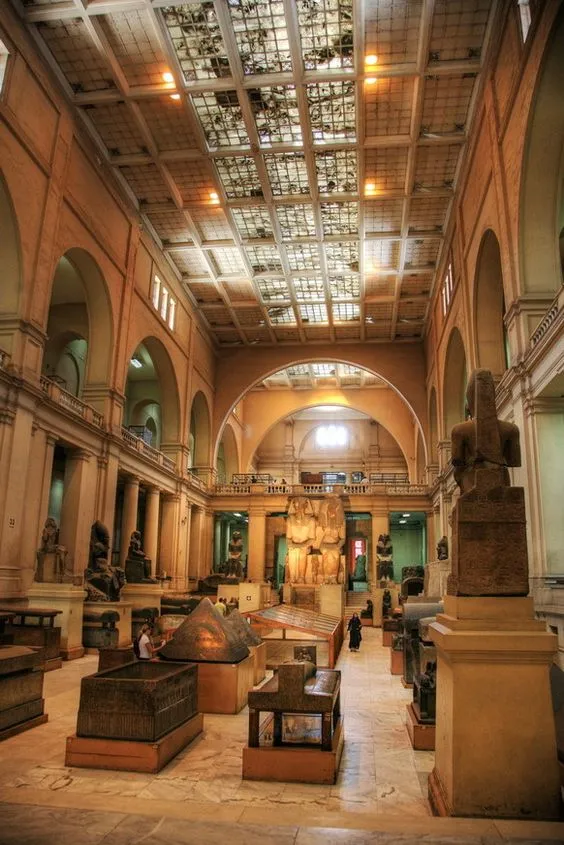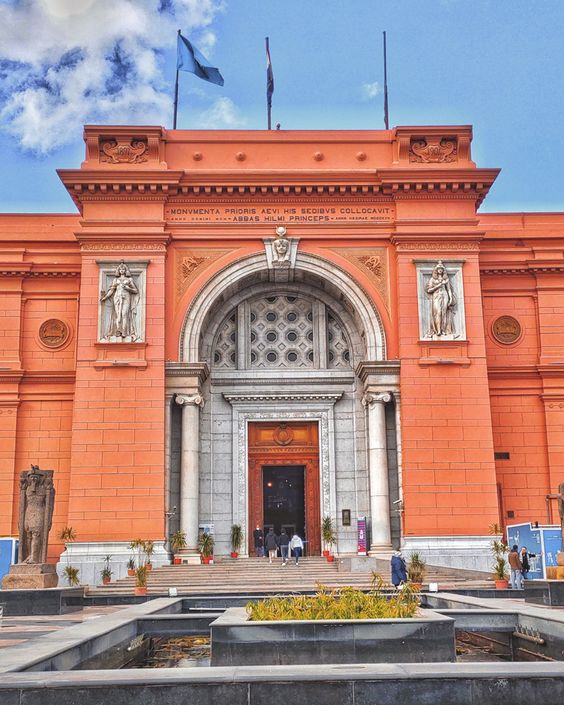Nestled in the heart of Cairo, the Egyptian Museum stands as one of the world’s most extraordinary museums, offering a captivating journey into the ancient world of the Pharaohs. With over 120,000 artifacts, it is the largest repository of ancient Egyptian antiquities, drawing visitors from across the globe who come to marvel at the vast collection of treasures, mummies, statues, and relics that tell the story of one of history’s most advanced civilizations.
A Historical Overview: The Egyptian Museum’s Origins

Whether you’re an archaeology enthusiast, a history lover, or simply a traveler seeking to understand Egypt’s rich cultural heritage, a visit to the Egyptian Museum in Cairo is a must. In this article, we explore the incredible history, collection, and significance of the Egyptian Museum, while providing essential information for visitors eager to experience this historical treasure trove.
The Egyptian Museum, or the Museum of Egyptian Antiquities, was officially opened in 1902 and has since become one of Cairo’s iconic landmarks. However, its inception dates back even further. The discovery of ancient Egyptian artifacts during the 19th century led to a wave of interest in Egyptian history. In 1835, under the reign of Muhammad Ali Pasha, the first steps toward preserving Egypt’s heritage were taken, establishing a small collection of relics in Bulaq.
The ever-growing number of discoveries made it clear that a larger, more permanent home for these treasures was needed. French Egyptologist Auguste Mariette played a pivotal role in establishing the museum. The museum was eventually moved to its current location in Tahrir Square, a neoclassical structure designed by French architect Marcel Dourgnon. The building itself is a testament to the merging of classical European architecture with Egyptian culture, serving as a gateway to Egypt’s glorious past.
A Collection Like No Other: Treasures of the Pharaohs
The Egyptian Museum’s collection is unparalleled in scope and significance. It boasts 120,000 pieces, making it the world’s largest collection of ancient Egyptian artifacts. The museum’s two floors are divided into chronological sections, displaying relics from the Pre-dynastic to the Greco-Roman periods.
Here are some of the most iconic exhibits you must see:
1. The Tutankhamun Galleries
Arguably the most famous section of the Egyptian Museum is the Tutankhamun exhibit. The discovery of the boy king’s nearly intact tomb in 1922 by British archaeologist Howard Carter was one of the greatest archaeological finds of all time.
The treasure trove of items from King Tutankhamun’s tomb includes over 5,000 artifacts, ranging from everyday objects to breathtaking treasures. The gold funerary mask of Tutankhamun, with its dazzling inlay of lapis lazuli and quartz, is a sight to behold. Visitors can also admire the golden sarcophagi, furniture, jewelry, and the famous Anubis shrine, all offering a glimpse into the life, death, and afterlife beliefs of the young Pharaoh.
2. Royal Mummy Room

The Royal Mummy Room is another significant highlight. Housing the mummified remains of some of Egypt’s most powerful rulers, it offers an extraordinary look into the ancient Egyptians’ complex rituals surrounding death and the afterlife. Among the mummies on display are Ramses II, Seti I, and Queen Hatshepsut.
These preserved bodies provide not only insight into the ancient embalming process but also a tangible connection to the people who once ruled Egypt. The careful arrangement of the mummies, combined with descriptions of their lives and reigns, makes this section particularly moving.
3. The Statue of Khafre
One of the museum’s most iconic pieces is the statue of Pharaoh Khafre, known for building the Great Pyramid of Giza. This magnificent sculpture, carved from diorite, stands as a symbol of the strength and authority of the Pharaohs. The statue’s serene and commanding expression, alongside the protective falcon god Horus, emphasizes Khafre’s divine kingship.
4. Jewelry and Daily Life Artifacts
Beyond the monumental statues and royal artifacts, the museum offers insight into the daily life of ancient Egyptians. Jewelry pieces, crafted from gold, silver, and precious stones, showcase the intricate workmanship of the time. Tools, pottery, and scarab amulets reveal how the ancient Egyptians lived, worked, and worshiped.
The museum also houses exquisite pieces from the tomb of Queen Ahhotep, including golden flies awarded as military medals and intricately designed jewelry, offering an intimate look into the lives of Egypt’s elite.
The Role of the Egyptian Museum in Preserving History
The Egyptian Museum does more than just display ancient treasures; it plays a crucial role in preserving Egyptian history and promoting research. Egyptologists from around the world come to study the artifacts, working to unlock the secrets of ancient Egypt’s religion, art, and society.
The museum has been at the center of archaeological discoveries, providing a space for scholars to conduct in-depth research into the objects and monuments housed within its walls. It also engages in conservation efforts, ensuring that the fragile artifacts are protected for future generations to appreciate.
Furthermore, the Egyptian Museum is instrumental in promoting cultural heritage education, both within Egypt and internationally. Through various educational programs and partnerships, the museum helps foster an appreciation for ancient Egyptian civilization, ensuring that its legacy continues to inspire curiosity and admiration worldwide.
The Future: The Grand Egyptian Museum
While the Egyptian Museum in Cairo remains a world-renowned institution, plans for the Grand Egyptian Museum (GEM) promise an even more spectacular experience for visitors. Located near the Giza Pyramids, the GEM is set to become the largest archaeological museum in the world when it opens fully.
The new museum will house many of the treasures currently on display at the Egyptian Museum, including the complete collection from King Tutankhamun’s tomb. With state-of-the-art technology, interactive exhibits, and more space to showcase Egypt’s ancient artifacts, the Grand Egyptian Museum will elevate the experience of exploring Egypt’s past to new heights.
Despite this exciting future development, the original Egyptian Museum will continue to serve as a historical and cultural landmark in Cairo, retaining its position as a beloved destination for history buffs and travelers alike.
Planning Your Visit: Essential Tips
For those planning a trip to Cairo, a visit to the Egyptian Museum should be at the top of your list. Here are some practical tips to ensure you make the most of your visit:
1. Timing and Tickets
The Egyptian Museum is open daily, though it’s best to arrive early to avoid the crowds. Guided tours are highly recommended, as they provide expert insights into the museum’s extensive collection. Entrance fees are modest, but additional charges apply for entry into the Royal Mummy Room and special exhibitions.
2. Museum Layout
The museum is divided into several sections, so having a map handy or joining a tour can help you navigate its vast collection. The ground floor focuses on larger statues, coffins, and papyri, while the upper floor houses the smaller yet equally impressive items, including the treasures of Tutankhamun.
3. Photography
While photography is allowed in most areas, certain restrictions apply in some exhibits, particularly where mummies are displayed. Be mindful of these rules, and always respect the preservation efforts of the museum.
4. Nearby Attractions
Since the museum is located in Tahrir Square, you’re ideally situated to explore other nearby landmarks, including the Cairo Tower and the historic Khan El Khalili Bazaar, where you can continue your immersion into Egyptian culture and history.
Final Thoughts: The Legacy of the Egyptian Museum
The Egyptian Museum in Cairo is not just a repository of ancient artifacts; it is a testament to Egypt’s enduring influence on world culture, art, and science. Each relic, each statue, and each piece of jewelry tells a story—stories of kings and queens, gods and goddesses, life and death, all interwoven into the grand narrative of human civilization.
Whether you’re captivated by the grandeur of the Pharaohs, the mysteries of mummification, or the artistry of ancient craftspeople, the Egyptian Museum offers an unparalleled window into a world that continues to inspire and awe. As the museum evolves and the Grand Egyptian Museum emerges on the horizon, Cairo remains a cornerstone of the world’s fascination with Egypt’s timeless treasures.

